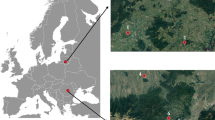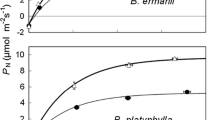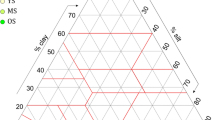Abstract
The first silver birch (Betula pendula Roth) plantations aimed at short-rotation forestry (SRF) management were established in Estonia in 1999 on former arable land, as experimental and demonstration areas of this novel land use and silvicultural system. Growth and plant–soil relations in such silver birch plantations have more often been studied at a young age (<10 years), while studies covering the later stages of the rotation period are rare. We used repeated monitoring of soil properties and tree growth in 11 midterm (15-year-old) SRF silver birch plantations to evaluate: (1) growth rate and productivity, (2) impact of soil physico-chemical properties on tree growth and (3) changes in the topsoil chemistry between young and midterm plantations. Growth and yield of midterm silver birch SRF plantations exceeded the best local birch forest yield table values by a factor of about 2. The best growth was observed on former agricultural soils corresponding to Oxalis and Oxalis-Myrtillus forest site types. Available water content in the topsoil layer (0–25 cm) had a significant positive effect on the growth rate of birches, with competitively dominant and medium trees more affected. The topsoil pHKCl (range 3.7–7.1) level had a negative effect on growth rate, especially in suppressed trees. The A-horizon of former agricultural soils had provided sufficient nutrients to ensure high productivity of the trees. During the 13 years between the two monitorings, concentrations of the topsoil total N and available P had remained at the same level, while available K and pHKCl had decreased significantly.






Similar content being viewed by others
References
Ahti T, Hamet-Ahti L, Jalas J (1968) Vegetation zones and their sections in northwest Europe. Ann Bot 5:169–211
Alriksson A, Eriksson HM (1998) Variations in mineral nutrient and C distribution in the soil and vegetation compartments of five temperate tree species in NE Sweden. For Ecol Manag 108:261–273
Alriksson A, Olsson MT (1995) Soil changes in different age classes of Norway spruce (Picea abies (L.) Karst.) on afforested farmland. Plant Soil 168–169(1):103–110
Augusto L, Bonnaud P, Ranger J (1998) Impact of tree species on forest soil acidification. For Ecol Manag 105(1–3):67–78
Bárcena TG, Gundersen P, Vesterdal L (2014) Afforestation effects on SOC in former cropland oak and spruce chronosequence resampled after 13 years. Glob Change Biol 20:2938–2952
Bates D, Maechler M, Bolker B, Walker S (2014) lme4: Linear mixed-effects models using Eigen and S4. R package version 1.1–6. http://CRAN.R-project.org/package=lme4
Berthrong ST, Jobbágy EG, Jackson RB (2009) A global meta-analysis of soil exchangeable cations, pH, and nitrogen with afforestation. Ecol Appl 19(8):2228–2241
Binkley D, Stape JL, Bauerle WL, Ryan MG (2010) Explaining growth of individual trees: light interception and efficiency of light use by Eucalyptus at four sites in Brazil. For Ecol Manag 259(9):1704–1713
Binkley D, Laclau JP, Sterba H (2013) Why on tree grows faster than another: patterns of light use and light use efficiency at the scale of individual trees and stands. For Ecol Manag 288:1–4
Bréda N, Granier A, Aussenac G (1995) Effects of thinning on soil and tree relations, transpiration and growth in an oak forest (Quercus petraea (Matt.) Liebl.). Tree Physiol 15:295–306
Carnol M, Bazgir M (2013) Nutrient return to the forest floor through litter and throughfall under 7 forest species after conversion from Norway spruce. For Ecol Manag 309:66–75
Daugaviete M, Krumina M, Kaposts V, Lazdinš A (2003) Farmland afforestation: the plantations of birch Betula pendula Roth on different soils. Baltic Forestry 9(1):9–21
De Schrijver A, Vesterdal L, Hansen K, De Frenne P, Augusto L, Achat DL, Staelens J, Baeten L, De Keersmaeker L, De Neve S, Verheyen K (2012a) Four decades of post-agricultural forest development have caused major redistribution of soil phosphorus fractions. Oecologia 169(1):221–234
De Schrijver A, De Frenne P, Staelens J, Verstraeten G, Muys B, Vesterdal L, Wuyts K, van Nevel L, Schelfhout S, De Neve S, Verheyen K (2012b) Tree species traits cause divergence in soil acidification during four decades of postagricultural forest development. Glob Change Biol 18(3):1127–1140
Ericsson T (1994) Nutrient cycling in energy forest plantations. Biomass Bioenergy 6(1–2):115–121
Falkengren-Grerup U, ten Brink DJ, Brunet J (2006) Land use effects on soil N, P, C, and pH persist over 40–80 years of forest growth on agricultural soils. For Ecol Manag 225:74–81
FAO (2006) FAO Guidelines for soil description, 4th edn. FAO, Rome
Forest Act (2006) RT I 2006 30:232
Grossiord C, Granier A, Gessler A, Pollastrini M, Bonal D (2013) The influence of tree species mixture on ecosystem-level carbon accumulation and water use in a mixed boreal plantations. For Ecol Manag 298:82–92
Henno O (1980) Arukaasikute kasvukäik põhilistes kasvukohatüüpides. EPA teaduslike tööde kogumik 128:80–89 (in Estonian)
Hinsinger P (2001) Bioavailability of soil inorganic P in the rhizosphere as affected by root-induced chemical changes: a review. Plant Soil 237:173–195
Huang M, Barbour SL, Elshorbagy A, Zettl JD, Si BC (2011) Water availability and forest growth in coarse textured soils. Can J Soil Sci 91:199–210
Hynynen J, Niemistö P, Viherä-Aarnio A, Brunner A, Hein S, Velling P (2010) Silviculture of birch (Betula pendula Roth and Betula pubescens Ehrh.) in northern Europe. Forestry 83(1):103–119
Hytönen J, Saramäki J, Niemistö P (2014) Growth, stem quality and nutritional status of Betula pendula and Betula pubescens in pure stands and mixtures. Scand J For Res 29(1):1–11
Ingestad T (1979) A definition of optimum nutrient requirements in birch seedlings. Physiol Plant 46(1):31–35
IUSS Working Group WRB (2014) World reference base for soil resources 2014. International soil classification system for naming soils and creating legends for soil maps. World Soil Resources Reports No. 106. FAO, Rome
Jaagus J, Mändla K (2014) Climate change scenarios for Estonia based on climate models from the IPCC Fourth Assessment Report. Est J Earth Sci 63(3):166–180
Jiménez E, Vega JA, Pérez-Gorostiaga P, Cuiñas P, Fonturbel T, Fernández C, Madrigal J, Hernando C, Guijarro M (2008) Effects of pre-commercial thinning on transpiration in young post-fire martime pine stands. Forestry 81(4):543–557
Jõgiste K, Vares A, Sendros M (2003) Restoration of former agricultural fields in Estonia: comparative growth of planted and naturally regenerated birch. Forestry 76(2):209–219
Johansson T (1999) Biomass equations for determining fractions of pendula and pubescent birches growing on abandoned farmland and some practical implications. Biomass Bioenergy 16:223–238
Johansson T (2007) Biomass production and allometric above- and below-ground relations for young birch stands planted at four spacings on abandoned farmland. Forestry 80(1):41–52
Kahle P, Hildebrand E, Baum C, Boelcke B (2007) Long-term effects of short rotation forestry with willows and poplar on soil properties. Arch Agron Soil Sci 53(6):673–682
Kahle P, Baum C, Boelcke B, Kohl J, Ulrich R (2010) Vertical distribution of soil properties under short-rotation forestry in Northern Germany. J Plant Nutr Soil Sci 173(5):737–746
Kalinina O, Chertov O, Dolgikh AV, Goryachkin SV, Lyuri DI, Vormstein S, Giani L (2013) Self-restoration of post-agrogenic Albeluvisols: soil development, carbon stocks and dynamics of carbon pools. Geoderma 207–208:221–233
Kellomäki S, Karjalainen T, Väisänen H (1997) More timber from boreal forests under changing climate? For Ecol Manag 94(1–30):195–208
Kitse E (1978) Soil water. Valgus, Tallinn (in Estonian)
Kiviste A (1997) Eesti riigimetsa puistute kõrguse, diameetri ja tagavara vanuseridade diferentsmudel 1984–1993. aasta metsakorralduse andmeil. Trans Estonian Agric Univ 189:63–75 (in Estonian with English summery)
Koski K, Rousi M (2005) A review of the promises and constraints of breeding silver birch (Betula pendula Roth) in Finland. Forestry 78(2):187–198
Kund M, Vares A, Sims A, Tullus H, Uri V (2010) Early growth and development of silver birch (Betula pendula Roth) plantations on abandoned agricultural land. Eur J For Res 129(4):679–688
Lagergren F, Lankreijer H, Kučera J, Cienciala E, Mölder M, Lindroth A (2008) Thinning effects on pine-spruce forest transpiration in central Sweden. For Ecol Manag 255:2312–2323
Liao C, Luo Y, Fang C, Chen J, Li B (2012) The effects of plantation practice on soil properties based on the comparison between natural and planted forests: a meta-analysis. Glob Ecol Biogeogr 21(3):318–327
Liepiņš K (2011) Growth of silver birch (Betula pendula Roth) in plantations on farmlands in Latvia. Mežzinātne 23(56):3–14 (in Latvian with English summary)
Liepiņš K, Rieksts-Riekstinš J (2014) Stemwood density of juvenile silver birch trees (Betula pendula Roth) from plantations on former farmlands. Baltic Forestry 19(2):179–186
Linder M, Maroschek M, Netherer S, Kremer A, Barbati A, Garcia-Gonzalo J, Seidi R, Delzon S, Corona P, Kolström M, Lexer MJ, Marchetti M (2010) Climate change impacts, adaptive capacity, and vulnerability of European forest ecosystems. For Ecol Manag 259(4):698–709
Lõhmus E (1974) Eesti metsade ordineerimisest ja klassifitseerimisest (ordination and classification of Estonian forests). Metsanduslikud uurimused (For Stud) 11:162–194 (in Estonian)
McLauchlan K (2006) The nature and longevity of agricultural impacts on soil carbon and nutrients. A review. Ecosystem 9(8):1364–1382
Messing I, Alriksson A, Johansson W (1997) Soil physical properties of afforested and arable land. Soil Use Manag 13:209–217
Nikodemus O, Kasparinskis R, Kukuls I (2013) Influence of afforestation on soil genesis, morphology and properties in glacial till deposits. Arch Agron Soil Sci 59:449–465
Nilson A (2006) Modeling dependence between the number of trees and mean tree diameter of stands, stand density and stand sparsity. In: Cieszewski C, Strub M (eds) Second international conference on forest measurement and quantitative methods and management & the 2004 Southern Mensurationists meeting 15–18 June 2004 Hot Springs, Arkansas USA. University of Georgia, Athens, USA, pp 74–94
Nohrstedt HÖ (2001) Response of coniferous forest ecosystems on mineral soils to nutrient additions: a review of Swedish experiences. Scand J For Res 16(6):555–573
Oikarinen M (1983) Growth and yield models for silver birch (Betula pendula) plantations in southern Finland. Commun Inst For Fenn 1–75 (in Finnish with English summary)
Otto MSG, Hubbard RM, Binkley D, Stape JL (2014) Dominant clonal Eucalyptus grandis × urophylla trees use water more efficiently. For Ecol Manag 328:117–121
Perala DA, Alm AA (1990) Reproductive ecology of birch: a review. For Ecol Manag 32:1–38
Persson T, Wirén A, Andersson S (1990) Effects of liming on carbon and nitrogen mineralization in coniferous forests. Water Air Soil Pollut 54(1):351–364
Peterson U, Aunap R (1998) Changes in agricultural land use in Estonia in the 1990s detected with multitemporal landsat MSS imagery. Landsc Urban Plan 41(3–4):193–201
Priha O, Smolander A (1997) Microbial biomass and activity in soil under Pinus sylvestris, Picea abies and Betula pendula at originally similar field afforestation sites. Biol Fertil Soils 24:45–51
Prishchepov VA, Müller D, Dubinin M, Baumann M, Radeloff VC (2013) Determinants of agricultural land abandonment in post-Soviet European Russia. L Use Policy 30(1):873–884
Pritchett WL, Fischer RF (1979) Properties and management of forest soils. Wiley, New York
Puri B, Murari K (1964) Studies in surface-area measurements of soils. 2. Surface area from a single point on the water isoterm. Soil Sci 97:341–343
R Core Team (2014) R: A language and environment for statistical computing. R Foundation for Statistical Computing, Vienna, Austria. http://www.R-project.org/
Repola J (2006) Models for vertical wood density of scots pine, Norway spruce and birch stems and their application to determine average wood density. Silva Fenn 40(4):673–685
Ritter E, Vesterdal L, Gundersen P (2003) Changes in soil properties after afforestation of former intensively managed soils with oak and Norway spruce. Plant Soil 249(3):319–330
Rosenvald K, Ostonen I, Truu M, Truu J, Uri V, Vares A, Lõhmus K (2011) Fine-root rhizosphere and morphological adaptations to site conditions in interaction with tree mineral nutrition in young silver birch (Betula pendula Roth) stands. Eur J For Res 130:1055–1066
Rubæk GH, Kristensen K, Olesen SE, Østergaard HS, Heckrath G (2013) Phosphorus accumulation and spatial distribution in agricultural soils in Denmark. Geoderma 209–210:241–250
Ruotsalainen S (2014) Increased forest production through forest tree breeding. Scand J For Res 29(4):333–344
Saetre P (1998) Decomposition, microbial community structure and earthworm effects along a birch-spruce soil gradient. Ecology 79:834–846
Saramäki J, Hytönen J (2004) Nutritional status and development of mixed plantations of silver birch (Betula pendula Roth) and downy birch (Betula pubescens Ehrh.) on former agricultural soils. Baltic Forest 10(1):2–11
Sohn JA, Gebhardt T, Ammer C, Bauhus J, Häberle KH, Matyssek R, Grams TEE (2013) Mitigation of drought by thinning: short-term and long-term effects on growth and physiological performance of Norway spruce (Picea abies). For Ecol Manag 308:188–197
Tammets T, Jaagus J (2013) Climatology of precipitation extremes in Estonia using the method of moving precipitation totals. Theor Appl Climatol 111:623–639
Telenius BF (1999) Stand growth of deciduous pioneer tree species on fertile agricultural land in southern Sweden. Biomass Bioenergy 16:13–23
Tullus A, Tullus H, Vares A, Kanal A (2007) Early growth of hybrid aspen (Populus tremula L. × P. tremuloides Michx.) plantations on former agricultural lands in Estonia. For Ecol Manag 245:118–129
Tullus A, Kanal A, Soo T, Tullus H (2010) The impact of available water content in previous agricultural soils on tree growth and nutritional status in young hybrid aspen plantations in Estonia. Plant Soil 333:129–145
Tullus A, Rytter L, Tullus T, Weih M, Tullus H (2012a) Short-rotation forestry with hybrid aspen (Populus tremula L. × P. tremuloides Michx.) in Northern Europe. Scand J For Res 27(1):10–29
Tullus A, Lukason O, Vares A, Padari A, Lutter R, Tullus T, Karoles K, Tullus H (2012b) Economics of hybrid aspen (Populus tremula L. × P. tremuloides Michx.) and silver birch (Betula pendula Roth.) plantations on abandoned agricultural lands in Estonia. Baltic Forestry 18(2):288–298
Tullus T, Tullus A, Roosaluste E, Kaasik A, Lutter R, Tullus H (2013) Understorey vegetation in young naturally regenerated and planted birch (Betula spp.) stands on abandoned agricultural land. New Forest 44(4):591–611
Uri V, Vares A, Tullus H, Kanal A (2007) Above-ground biomass production and nutrient accumulation in young stands of silver birch on abandoned agricultural land. Biomass Bioenergy 31:195–204
Uri V, Lõhmus K, Mander Ü, Ostonen I, Aosaar J, Maddison M, Helmisaari HS, Augustin J (2011) Long-term effects on the nitrogen budget of a short-rotation grey alder (Alnus incana (L.) Moench) forest on abandoned agricultural land. Ecol Eng 37:920–930
Uri V, Varik M, Aosaar J, Kanal A, Kukumägi M, Lõhmus K (2012) Biomass production and carbon sequestration in a fertile silver birch (Betula pendula Roth) forest chronosequence. For Ecol Manag 267:117–126
Van Cleve K, Yarie J, Erickson R, Dyrness CT (1993) Nitrogen mineralization and nitrification in successional ecosystems on the Tanana River floodplain, interior Alaska. Can J For Res 23:970–978
Vares A (2005) The growth and development of young deciduous stands in different site conditions. The Thesis for Applying the Doctors’s Degree in Agricultural Sciences in Forestry, Estonian Agricultural University, Tartu
Vares A, Jõgiste K, Kull E (2001) Early growth of some deciduous tree species on abandoned agricultural lands in Estonia. Baltic Forest 7(1):52–58
Vares A, Uri V, Tullus H, Kanal A (2003) Height growth of four fast-growing deciduous tree species on former agricultural lands in Estonia. Baltic Forest 9(1):2–8
Varik M, Aosaar J, Ostonen I, Lõhmus K, Uri V (2013) Carbon and nitrogen accumulation in belowground tree biomass in a chronosequence of silver birch stands. For Ecol Manag 302:62–70
Vervaet H, Massart B, Boeckx P, Van Cleemput O, Hofman G (2002) Use of principal component analyses to assess factors controlling net N mineralization in deciduous and coniferous forests. Biol Fert Soils 36:93–101
Vladychenskii AS, Telesnina VM, Rumyantseva KA, Filimonova SI (2009) Dynamics of some properties in postagrogenic soils of Southern Taiga in the course of plant succession. Mosc Univ Soil Sci Bull 64(1):1–9
Vladychenskii AS, Telesnina VM, Rumyantseva KA, Chalaya TA (2013) Organic matter and biological activity of postagrogenic soils in the Southern Taiga using the example of Kostroma Oblast. Eurasian Soil Sci 46(5):518–529
Wall A, Heiskanen J (2003) Water-retention characteristics and related physical properties of soil on afforested agricultural land in Finland. For Ecol Manag 186(1–3):21–32
Wall A, Hytönen J (2005) Soil fertility of afforested arable land compared to continuously forested sites. Plant Soil 275(1–2):247–260
Weih M (2004) Intensive short rotation forestry in boreal climates: present and future perspectives. Can J For Res 34:1369–1378
Yearbook Forest 2013 (2014) Estonian Environmental Agency, Tartu
Acknowledgments
This study was supported by institutional research funding IUT (Grants IUT21-4 and IUT34-9) of the Estonian Ministry of Education and Research and by the EU through the European Regional Development Fund (Centre of Excellence ENVIRON). The authors are also thankful to Ants Kaasik for his help in statistical analysis. Ilmar Part is acknowledged for English proofreading.
Author information
Authors and Affiliations
Corresponding author
Additional information
Communicated by Agustín Merino.
Rights and permissions
About this article
Cite this article
Lutter, R., Tullus, A., Kanal, A. et al. Growth development and plant–soil relations in midterm silver birch (Betula pendula Roth) plantations on previous agricultural lands in hemiboreal Estonia. Eur J Forest Res 134, 653–667 (2015). https://doi.org/10.1007/s10342-015-0879-x
Received:
Revised:
Accepted:
Published:
Issue Date:
DOI: https://doi.org/10.1007/s10342-015-0879-x




